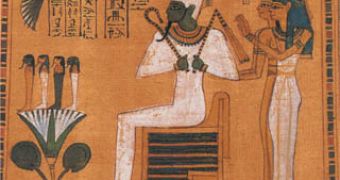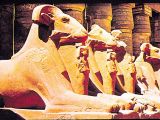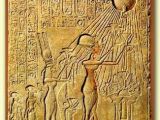The pantheon of the ancient Egyptians was rich in diverse deities. The question inevitably arises: how could this polytheist religion influence later monotheist religions?
The Sun God
The main Egyptian deity was Amon Re, the king of all gods and the Sun God. The Sun had a central position in the religion of the ancient Egyptians. First, it was represented as the golden scarab Hepri, symbolizing the coming into being. Then, the hieroglyph of the Sun, or Ra (Re), appeared as a circle with a point in the middle.
A first rank god, Ra was the Sun as source of vital force, the supreme judge of the Universe. Worshiped in Egypt as the creator and the supreme god, Ra had his religious center at Heliopolis ("The City of the Sun" in Greek, "Baalbek" in Egyptian), found in the south of the Nile Delta. It was also named Atum ("Pesedjet" in Egyptian, meaning the reunion of the main gods).
Ra first came into being by separating himself from the primordial chaos or from a lotus flower, fed by the waters of the beginning. He went out as the Benu (Phoenix) bird, launched in flight from the pyramidal top of a stone obelisk. The gold-covered obelisk was the holiest object from the temple of Ra at Heliopolis, representing the fecundating ray of the god (with all that, it was by no means a phallic symbol). Ra also protected the pyramids, considered to be solar constructions symbolizing the three ages: child at dawn (Heprer), adult at middle day (Ra), and elder at evening (Atum).
At dawn, Ra steps out of the eastern waters, greeted by the cheerful choir of the 7 sacred baboons of the monkey-god Thot, which, woken up by the first light, execute a ritual dance. Then, Ra mounts the boat of day and floats until evening, when he gets into the boat of night and starts to navigate towards its end; at the same time, Ra is fighting back the repeated attacks of the dragon Apophis, coming from the depths of the Nile of the skies. Each morning, Ra comes out of the confrontation victorious but, at the end of the times, he takes the shape of a fire tomcat and kills Apophis.
Seeing him aged, people conspired against Ra, the supreme ruler of the Earth. Ra consulted with the other gods as well, and then sent the lioness-goddess Sehmet (The Eye of Ra) to the mortals. For her force and rage, she symbolizes the killing power of the Sun. Ra's initial aim was just to dwindle the number of humans but, blinded by rage and blood thirst, Sehmet did unleashed massacre upon massacre upon mortals. Ra was then forced to appeal to a trick, flooding her path with brandy as red as blood. The drunk lioness forgot her rage but naturally, when she woke up, she felt offended.
Disappointed with people, Ra retreated on the back of Nut, the cow of the skies. Angry with the Egyptians, The Eye of Ra exiled herself in Nubia, a country of black people located south of Egypt. Deprived of her presence, the kingdom fell into chaos. The gods sent ambassadors to appease the lioness, in a mission accomplished by Thot. The lioness turned into the sacred cat Bastet or, as another legend goes, into the cow-headed goddess of the love desire, and returned to Egypt to everybody's delight.
The cult of Ra was very active in Egypt during all periods. In Theba, the political and religious capital, Ra was identified with Amon, a god supported and adored especially by the great priests. At the beginning, Amon was just an obscure god of the wind. His cult flourished rapidly at Theba during the Middle Kingdom, when he was worshiped as the god of air and fecundity, being represented as a human with an iron crown and a ram's head; his assigned animals were the ram and the goose. The soul of Amon was represented as a ram-headed Sphinx in the snake-shaped Egyptian scepter, Kematef. Amon had great temples at Etfu, Dendera, Abydos and Karnak.
After chasing off the Hyksos (Semite invaders) in the 16th century BC, Amon turned into the supreme god of the freed kingdom. As the national god, worshiped by the priests who had turned into pharaohs, he was called Amon-Ra. The new syncretic god was also granted supplementary attributes; to honor him, temples were raised in Theba, but the most distinguished of them all must be the Great Temple in Luxor, raised by Amenophis III, back in a time when Amon-Ra was called "king of gods, the creator of the Universe, the author of all things, time conductor and direct master of the Sun, sky and the underworld".
After the 18th dynasty of the New Kingdom, around 1,450 BC, the autonomous cult of Aton, the solar disk, worshiped as the concrete shape of Ra, emerged. It was represented as a red disk with palmed rays surrounded by the sacred snake. Under the pharaoh Amenophis IV (1372-1354 BC), Aton's cult officially replaced Amon-Ra's cult. It was an act of authority on part of the pharaoh, as priests considered the new orientation a heresy. Amenophis IV or Amenothes (which translates to "Amon is pleased") adopted a royal name: Akhenaton ("the one over whom the benevolence of Aton flows").
The introduction of the entire cult of Aton was an attempt at instituting a monotheist religion (adoration of a sole god), but both the polytheist tradition (the faith in more than one god) of the Egyptians and the short rule of Akhenaton, just 18 years, hampered with the universal and longstanding installation of monotheism. In 1370 BC, Akhenaton and his wife Nefertiti built the city of Ahet-Aton ("The Horizon of Aton"), today Tel el-Amaran, aimed to turn into the pan-Egyptian center of the cult of the new unique god. Even if the monotheist cult of Aton did not survive after the death of Akhenaton, it seems that its echoes are to be found today in the Mosaic religion. For instance, one of the psalms of the Old Testament is inspired from an hymn to Aton. Were we to think even further, the monotheist religion of Judaism, Christianity and Islam have all something to do with this out of his time pharaoh, Akhenaton.
Osiris, the lord of the other world
In the ancient mythology and religion of the Egyptians, Osiris was one of the supreme gods. On several inscriptions, he was called "king of forever", "master of the infinite" and "sovereign of the gods and people". The myths say his father was Geb, the god of Earth, and his mother was Nut, the goddess of the sky. He married Isis, the mother-nature. Their son was Horus, the falcon-headed child-god, a solar divinity.
This deity was represented as a human-god. Once, Osiris was a good and kind king, who taught people to work the land, cultivate vine, and gave right and just laws. But his evil twin brother, Set, driven by hate and jealousy decided to overthrow him and take his wife. He killed Osiris, throwing his body into the waters of the Nile River. By magic, Isis discovered the body and temporarily buried it, then departing to search for Horus.
In her absence, by chance, Set discovered the body of Osiris and in order to definitively get rid of him, he cut the body in 14 pieces, which he spread in all directions. Using her magic art, Isis managed to gather the pieces, and revive her husband with the help of Horus, which had fought and defeated Set. Osiris became the king of the netherworld, the master of the souls of the dead. These were brought to him and their deeds were judged and weighed. Those that had lived a life of dignity reached his sky empire, where they had a life of plenty and eternal happiness.
The revivification myth of Osiris, symbol of the cyclic revival of nature, had a strong influence on the genesis of the myth of Messiah. Osiris deciding who went into the Egyptian "sky paradise" and who not may sound similar to what the Great Inquest was doing.
Osiris is not the same god with Anubis (Inpu), the jackal-headed god of mummification and the afterlife. Crocodiles were sacred in ancient Egypt and this is why they were even embalmed; large embalmed crocodiles were found in many tombs and sacred edifices. Egyptians also used to embalm baboons, cats, dogs, falcons, mice (representing the hearts of the sinners, offered to Osiris).
A sacred bird was the ibis. Thoth, one of the two deities (the other being Ma'at or Maat, the goddess of truth and justice) that stood on either side of Ra's boat, and patron of arbitration, magic, writing, science, and the judging of the dead, had an ibis head.

 14 DAY TRIAL //
14 DAY TRIAL // 

